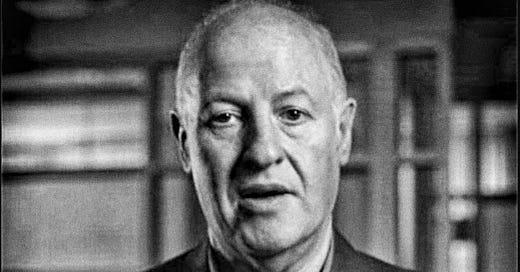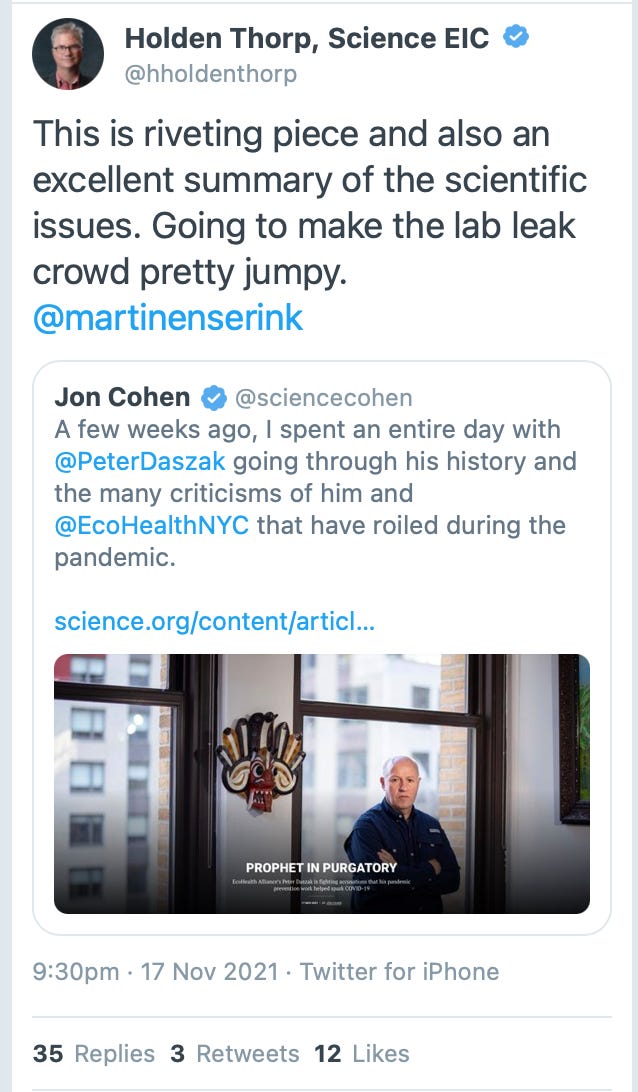Pursued On All Sides By Journalists and Congress, Peter Daszak Seeks Refuge At Science Magazine
Enough with silly nonreporting reporting, send the subpoenas.
5 minute read
Over the summer, I sent Science Magazine a series of questions trying to understand their clumsy reporting on the COVID-19 pandemic. Biosafety experts told me that Science was biased in favor of a theory that the COVID-19 pandemic started from a natural spillover, and ignored inquiries from Republicans in Congress who are suspicious about research at the Wuhan Institute of Virology. I was also told that science writers at the publication were overly friendly with Peter Daszak, who runs a nonprofit called EcoHealth Alliance that funds research at the Wuhan Institute of Virology, where some suspect the pandemic began.
“If substantive new information relevant to the lab-leak hypothesis emerges in Congressional inquiries, we will certainly cover it,” wrote Tim Appenzeller, the News Editor for Science. “We are journalists, and fascinated by the question of the pandemic’s origin. As more clues emerge, we will cover them.”
It turns out, they’re not very fascinated and they didn’t bother to cover them.
In late October, House Republican investigators released details about the National Institutes of Health inadequate oversight of grants that NIH provided to the EcoHealth Alliance. These details arose from a bipartisan “in camera” review of documents conducted at the Department of Health and Human Services (HHS) that was monitored by HHS staff. (For science writers, in camera review means the documents were examined in chambers. In this case, because the NIH refuses to make the documents public.)
The review found:
NIH terminated an EcoHealth Alliance grant in April 2020, reinstated the grant and then suspended the grant in July 2020 because of EcoHealth’s inadequate oversight of research at the Wuhan Institute of Virology;
EcoHealth Alliance refused to provide information to the NIH related to its subaward to the Wuhan Institute of Virology;
NIH failed to report EcoHealth’s noncompliance and grant suspension into the www.SAM.gov database that alerts other U.S. Government agencies to risky grant recipients;
NIH allowed EcoHealth Alliance to determine that their research with chimeric viruses was not “gain-of-function” because they were using a WIV1 virus backbone which EcoHealth alleged to the NIH had “never been demonstrated to infect humans or cause human disease.” As reported by The New Yorker, WIV1 is “known to be potentially dangerous to humans.”
But these details don’t paint a favorable portrait of biotechnology, and they make the NIH and EcoHealth Alliance look sloppy and deceptive. Maybe this is why Science Magazine didn’t cover this? Instead, editors at Science had Jon Cohen spend seven hours with Peter Daszak (seriously, seven hours!) to write almost 5,000 words that tell us nothing new, but instead puts a nice gloss on Daszak, an outcome celebrated by Science Magazine’s Editor-in-Chief Holden Thorpe.
No tough questions
Before you spend time reading Cohen’s chummy profile, you should know that Daszak has blocked most people on Twitter who have dared ask him any hard questions, including reporter Alison Young. The most experienced reporter on lab accidents in the United States, Young is the past president of the board of Investigative Reporters and Editors, and is director of the Missouri School of Journalism’s Washington Program.
Considering her investigative background, it’s easy to understand why Daszak avoids Young in favor of spending an entire day relaxing and chatting with Science Magazine’s Jon Cohen. Cultivating media is important, Daszak explained to fellow scientists in a 2016 workshop, because of “the strong influence the media can have on public perception of threats,” which is critical for continued funding of Daszak’s research.
A key driver is the media, and the economics follow the hype. We need to use that hype to our advantage to get to the real issues. Investors will respond if they see profit at the end of process, Daszak stated.
But it’s not just Young. In the past several months, Daszak has dodged questions from The BMJ, The Atlantic, The Intercept, and The Daily Mail, and he has evaded multiple congressional inquiries.
“His grants were federal funds, and it is entirely appropriate for Congress to insist on accountability and transparency,” the Washington Post editorial board wrote last month as it called for Daszak to answer before Congress. “He might also help the world understand what really happened in Wuhan.”
Or Daszak might spend an entire day with Jon Cohen to help the world understand that, although misunderstood and hounded by conspiracies, he has “maintained [his] integrity.”
A martyr “crucified” after a “witch hunt”?
In addition to spending multiple paragraphs on Daszak’s family and time growing up in England, Cohen feeds readers comments from a bunch of scientists who complain that Daszak has been “crucified” because of a “witch hunt” and sprinkles the profile with commentary from the NIH’s David Morens saying that Daszak should be celebrated, not condemned. “Peter is the smartest guy in the room with respect to these coronaviruses,” Morens told Cohen.
What Cohen didn’t tell readers is that Morens is also Daszak’s funder, colleague, co-author, and ardent defender.
After President Biden pledged “we will do everything we can to trace the roots of this outbreak” in order to prevent the next one, Morens poo-pooed the President’s promise. “[A]t some point, it crosses over from doing due diligence to wasting time and being crazy,” Morens told National Geographic of the world’s need to find the pandemic’s origin. “We may have seen that point already.”
Not all in the profile is bright and shiny, but that’s because of leaks from the Department of Defense, investigative reporting by other media outlets, freedom of information requests (FOIA) by U.S. Right to Know, and documents made public by a group of “internet sleuths” called DRASTIC who are often denigrated by science writers and virologists for uncovering inconvenient truths.
This information should have been the core of the story, but it appears almost begrudgingly, carefully hidden in plain sight, as if editors at Science were worried that they would be humiliated on Twitter if they left it out. Nonetheless, they allow virologist Angela Rasmussen to dismiss as “weaponized FOIA requests” the hard work that went into gathering some of this evidence.
If you get through the first 4,500 words of the Cohen profile, you still have to slog through a few hundred more until it ends with Daszak complaining that suspicions the virus escaped from the Wuhan lab will live on, implying that people are not smart enough to see the world with his clarity.
Of course, it’s hard for suspicions to die when new clues of Daszak’s mendacity keep popping up.
A few days after Science published Cohen’s soft-focus profile, Daszak was confronted with further evidence that the pandemic could have started due to his own research and collaboration with the Wuhan Institute of Virology.
Writing in the Spectator, author Matt Ridley noted that Peter Daszak’s EcoHealth Alliance had shipped viruses found in bats living in Laos to the Wuhan Institute of Virology for research. These bat viruses from Laos are the closest related viruses to the SARS-CoV-2 virus which started the pandemic. Daszak tried to debunk the article with a statement from the EcoHealth Alliance on Twitter, but his own documents belie this.
In 2015, Daszak updated the NIH about the work he was doing on the grant they provided him with the Wuhan Institute of Virology as one of his collaborating institutions.
Daszak’s grant update to the NIH describes collecting samples from bats “in 5 provinces and in Laos.”
According to a table of accomplishments for 2014, Daszak reported to the NIH that EcoHealth Alliance had collected 121 bat fecal samples in Laos to test for viruses.
So, yes. People are going to continue to doubt what comes out of Peter Daszak’s mouth and rely on his own documents and emails instead. No matter how complimentary a profile Science Magazine can cobble together. Even if they put his photo on the cover.
The time is long behind us for this type of silly nonreporting reporting by the science writers Daszak has cultivated. It’s time for subpoenas. Time for Daszak to appear before Congress. Time for some real public accountability.













Thank you Mr. Thacker for your superb work. I'm a Brazilian reporter and I've cited two of your pieces in an analysis of Science's latest paper on the supposed zoonotic origin. I work for Gazeta do Povo, a conservative newspaper.
Wow.